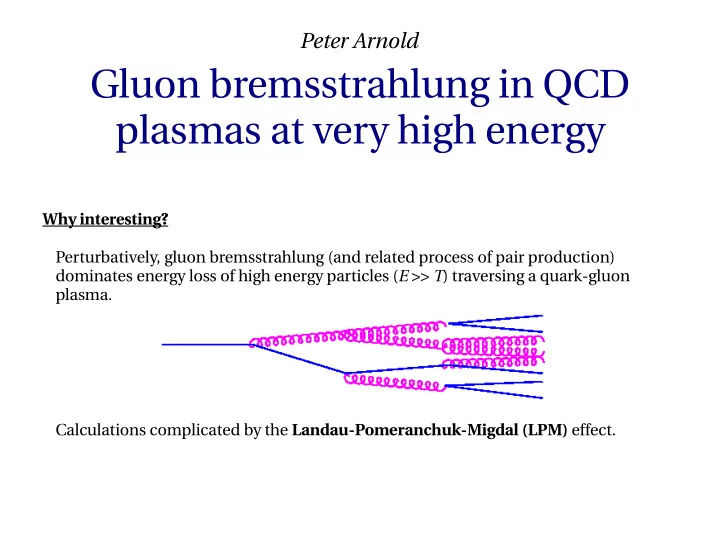

Peter Arnold Gluon bremsstrahlung in QCD plasmas at very high energy Why interesting? Perturbatively, gluon bremsstrahlung (and related process of pair production) dominates energy loss of high energy particles ( E >> T ) traversing a quark-gluon plasma. Calculations complicated by the Landau-Pomeranchuk-Migdal (LPM) effect.
The LPM Effect Naively brem rate ~ n σ v ~ (density of scatterers) × × 1 Problem At very high energy, probabilities of brem from successive scatterings no longer independent; brem from several successive (small angle) collisions not very different from brem from one collision. Result : a reduction of the naive brem rate.
I. Review of the LPM effect QED 1953-56, QCD 1996-98 II. A theoretical puzzle III. Its resolution
The LPM Effect (QED) Warm-up : Recall that light cannot resolve details smaller than its wavelength. [Photon emission from different scatterings have same phase coherent.] Now: Just Lorentz boost above picture by a lot!
The LPM Effect (QED) Note: (1) bigger E requires bigger boost → more time dialation → longer formation length (2) big boost → this process is very collinear.
An alternative picture versus Are these two possibilities in phase? Do they interfere coherently? YES if (i) everything is nearly collinear ✓ (ii) particle and photon have nearly same velocity ✓ ( speed of light)
The important point: The more collinear the underlying scattering, the longer the formation time. Note : the formation length depends on the net angular deflection during the formation length, which depends on the formation length [ Self-consistency → standard parametric formulas for formation length. ]
The LPM Effect (QCD) There is a qualitative difference for soft bremsstrahlung.: QED Softer brem photon → longer wavelength → less resolution → more LPM suppression QCD Unlike a brem photon, a brem gluon can easily scatter from the medium. Softer brem gluon → easier for brem gluon to scatter → less collinearity → less LPM suppression vs. Upshot: Soft brem more important in QCD than in QED (for high- E particles in a medium)
A theoretical puzzle (background) -
A theoretical puzzle (background) -
A theoretical puzzle (background) - Naively: medium effect grows linearly with L .. For small enough L , instead grows like L 2 ln L because of the LPM effect. [BDMPS 1996]
A theoretical puzzle (background) - Naively: medium effect grows linearly with L .. For small enough L , instead grows like L 2 ln L because of the LPM effect. [BDMPS 1996] Assumptions I will make in this talk: and moreover and moreover mean free path for elastic collisions formation length
The puzzle Treating ln( E / T ) >> 1, and trying to analyze the problem to leading order in inverse powers of this logarithm: Harmonic oscillator (HO) approximation [BDMPS] Consider only typical scattering events (no rare, large-than-usual scatterings) single scattering ( N =1) approximation [GLV , Salgado & Wiedemann] Consider only one scattering from medium (both typical and rare deflection angles) Naively, this might seem weird given my assumption that mean free path for elastic collisions
The puzzle: energy loss Treating ln( E / T ) >> 1, and trying to analyze the problem to leading order in inverse powers of this logarithm: Harmonic oscillator (HO) approximation [BDMPS] single scattering ( N =1) approximation [GLV , Salgado & Wiedemann]
The puzzle: spectrum vs. L for fixed ω harmonic oscillator (HO) single scattering ( N =1) approximation [BDMPS] approximation Which approximation, if either, is right (at leading log order)? [ Zakharov 2001, BDMS 2001, Peigne & Smilga 2008, Arnold 2009 ]
The puzzle: spectrum vs. L for fixed ω harmonic oscillator (HO) single scattering ( N =1) approximation [BDMPS] approximation Which approximation, if either, is right (at leading log order)? Answer: They're both important. [ Zakharov 2001, BDMS 2001, Peigne & Smilga 2008, Arnold 2009 ]
Scattering probabilities net transverse momentum transfer in distance L net deflection angle rare typical typical
Return to thin media puzzle Typical scatterings Probability of underlying scattering event large but relatively small deflection angle → large formation time → small medium effect on brem - = small Rare scatterings Probability of underlying scattering event small but relatively large deflection angle → small formation time → significant medium effect on brem - = large
Return to thin media puzzle Typical scatterings Probability of underlying scattering event large but relatively small deflection angle → large formation time → small medium effect on brem - = small Rare scatterings Probability of underlying scattering event small but relatively large deflection angle → small formation time → significant medium effect on brem - = large
underlying scattering prob. LPM suppression Brem probability Which peak wins depends on frequency ω of gluon.
∆ (spectrum) vs. L for fixed ω Total ∆ E as function medium size L = formation time in infinite medium
Lessons The LPM effect is easy to understand qualitatively. When computing average quantities like < ∆ E >, the average is sometimes dominated by extremely rare events and so is not characteristic of what happens in most events.
Scattering probabilities net transverse momentum transfer in distance L net deflection angle rare typical
in weakly-coupled plasmas formation time depends on collinearity of brem depends on transverse momentum transfer Q ⊥ for large q ⊥ squared transverse momentum transfer per unit length UV log divergent (leading order)
in weakly-coupled plasmas formation time depends on collinearity of brem depends on transverse momentum transfer Q ⊥ for large q ⊥ squared transverse momentum transfer per unit length UV log divergent (leading order)
Leading-order-in- α s result for UV-regulated qhat Pure gluon gas, for example: Λ = UV cut-off on q ⊥ [Arnold & Xiao(2008)] WARNING: Corrections which are formally higher-order in coupling, of order m d / T = O( g ). are of order 100% for realistic couplings. [Caron-Huot (2008)]
Recommend
More recommend